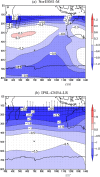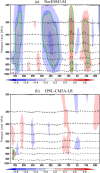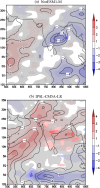The mechanism linking the variability of the Antarctic sea ice extent in the Indian Ocean sector to Indian summer monsoon rainfall
- PMID: 36034493
- PMCID: PMC9400001
- DOI: 10.1007/s00382-022-06466-z
The mechanism linking the variability of the Antarctic sea ice extent in the Indian Ocean sector to Indian summer monsoon rainfall
Abstract
The study investigates the mechanism of teleconnection between the variability of sea ice extent (SIE) in the Indian Ocean sector of the Southern Ocean and the variability of Indian summer monsoon rainfall. We utilized reanalysis, satellite, in-situ observation data, and model output from the coupled model intercomparison project phase 5 (CMIP5) from 1979 to 2013. The empirical orthogonal function (EOF) and correlation analysis show that the first and third modes of principal component (PC1 and PC3) of SIE in the Indian Ocean sector during April-May-June (AMJ) are significantly correlated with the second mode of principal component (PC2) of Indian summer monsoon rainfall. The reanalysis data revealed that the changes in the SIE in the Indian Ocean sector excite meridional wave train responses along the Indian Ocean for both principal component modes. Positive (negative) SIE anomalies based on first and third EOFs (EOF1 and EOF3), contribute to the strengthening (weakening) of the Polar, Ferrel, and Hadley cells, inducing stronger (weaker) convective activity over the Indian latitudes. The stronger (weaker) convective activity over the Indian region leads to more (less) rainfall over the region during high (low) ice phase years. Furthermore, a stronger (weaker) polar jet during the high (low) ice phase is also noted. The selected CMIP5 models captured certain atmospheric teleconnection features found in the reanalysis. During AMJ, the SIE simulated by the NorESM1-M model was significantly positively correlated with Indian summer monsoon rainfall, whereas the IPSL-CM54-LR model showed a negative correlation.
Keywords: Antarctic sea ice extent (SIE) in the Indian Ocean sector; Convective activity; High ice phase; Indian summer monsoon rainfall; Low ice phase.
© The Author(s), under exclusive licence to Springer-Verlag GmbH Germany, part of Springer Nature 2022, Springer Nature or its licensor holds exclusive rights to this article under a publishing agreement with the author(s) or other rightsholder(s); author self-archiving of the accepted manuscript version of this article is solely governed by the terms of such publishing agreement and applicable law.
Conflict of interest statement
Conflict of interestThe authors have no relevant financial or non-financial interests to disclose.
Figures

















References
-
- Azhar SS, Chenoli SN, Samah AA, Kim SJ. The linkage between Antarctic sea ice extent and Indian summer monsoon rainfall. Polar Sci. 2020;25(100537):1–10. doi: 10.1016/j.polar.2020.100537. - DOI
-
- Bajish CC, Jena B, Anilkumar N. Is the Indian monsoon rainfall linked to the Southern Ocean sea ice conditions? Weather Clim Extrem. 2021;34(100377):1–8.
-
- Bi D, Dix M, Marsland SJ, O’Farrell S, Rashid HA, Uotila P, Hirst AC, Kowalczyk E, Golebiewski M, Sullivan A, Yan H, Hanna N, Franklin C, Sun Z, Vohralik P, Watterson I, Zhou X, Fiedler R, Collier M, Ma Y, Noonan J, Stevens L, Uhe P, Zhu H, Hill R, Harris C, Griffies S, Puri K. The ACCESS coupled model: description, control climate and preliminary validation. Aust Met Oceanog J. 2013;63:41–64. doi: 10.22499/2.6301.004. - DOI
-
- Bracegirdle T, Holmes C, Holland P. Compensating biases and a noteworthy success in the CMIP5 representation of Antarctic sea ice processes. Geophys Res Lett. 2019;46:4299–4307. doi: 10.1029/2018GL081796. - DOI
LinkOut - more resources
Full Text Sources
Research Materials
Miscellaneous
